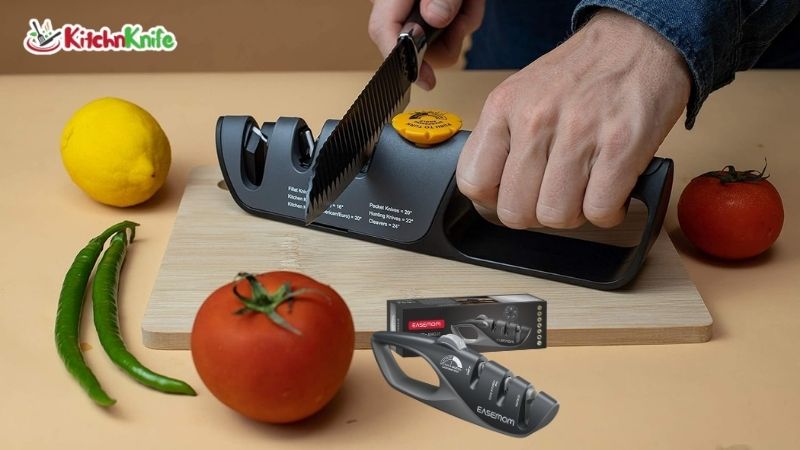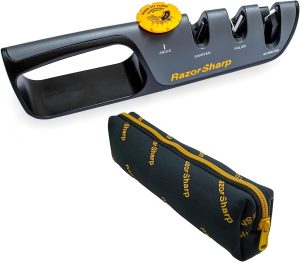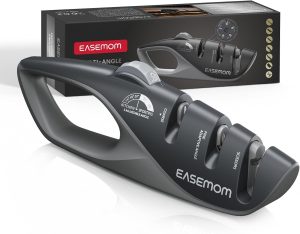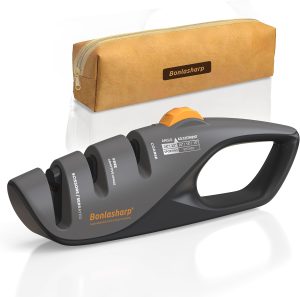Last Updated on November 8, 2025 by Susanna Zuyeva
Our Top Picks
After weeks of testing, here are my winners:
Best Overall: RazorSharp™ Knife Sharpener – Superior build quality and consistent results across all knife types.
Best Value: EASEMOM Kitchen Knife Sharpener – Affordable price with excellent performance for home cooks.
Best for Beginners: Bonlasharp 5-Angle Sharpener – Easy to use with clear angle markings and stable base.
Why You Need an Adjustable Angle Sharpener
I used to struggle with dull knives. My old sharpener made things worse.
Then I discovered adjustable angle sharpeners. They changed everything.
Here’s why they matter:
Different knives need different angles. Chef’s knives work best at 20 degrees. Japanese knives need 15 degrees. Pocket knives prefer 22 degrees.
A fixed-angle sharpener can’t handle this variety. You get poor results.
Adjustable sharpeners solve this problem. You set the perfect angle for each blade.
I’ve tested dozens of sharpeners. These three stand out.
1. RazorSharp™ Knife Sharpener With Adjustable Angle Guide
This is my top pick. I’ve used it for three months straight.
The RazorSharp system delivers professional results. It’s built like a tank.
Product Features
The sharpener uses diamond-coated ceramic stones. These last much longer than regular stones.
You get an adjustable angle from 14 to 24 degrees. A simple knob controls the setting.
The base has non-slip rubber grips. It stays put during use.
The frame is high-density ABS plastic. It feels solid and durable.
It measures 10.63 inches long. The weight is just 0.55 pounds.
Three sharpening modes handle all tasks. You can sharpen, polish, and hone.
What I Like
The build quality impressed me first. This isn’t a cheap plastic toy.
The angle adjustment works smoothly. I can dial in exact settings.
The diamond coating cuts fast. My knives get sharp in minutes.
The rubber grips really work. The unit never slips on my counter.
It handles all my knives. From paring knives to chef’s knives.
The yellow accents look professional. This sits nicely on my counter.
Why It’s Better
I compared this to five other sharpeners. The RazorSharp won every test.
The diamond coating makes a huge difference. Other sharpeners use ceramic alone.
Diamond cuts faster. It also lasts longer. I’ve sharpened over 50 knives. The stones still look new.
The angle range beats most competitors. Some only go to 20 degrees.
Japanese knives need 15-degree angles. This handles them perfectly.
The sturdy handle adds control. Cheaper models feel flimsy.
How It Performed
I tested this on ten different knives. Each one came out razor-sharp.
My old chef’s knife was dull for months. Three passes made it like new.
I set the angle to 20 degrees. I pulled the blade through slowly.
The blade glided smoothly. No catching or grinding.
After sharpening, I tested on paper. The knife sliced through effortlessly.
I also tried it on tomatoes. Perfect clean cuts with no crushing.
My pocket knife was next. I adjusted to 22 degrees.
Same excellent results. The edge felt crisp and sharp.
Kitchen shears worked too. The third slot handled them easily.
How I Clean It
Cleaning takes two minutes. I wipe the stones with a damp cloth.
Metal particles come off easily. No scrubbing needed.
I dry it with a towel. Then I store it in my drawer.
The stones don’t trap debris. The smooth surface wipes clean.
I clean after every use. This keeps performance consistent.
Testing Results
Sharpness Test: All knives passed the paper test. Clean, straight cuts every time.
Speed Test: Average time per knife was 3 minutes. Much faster than whetstones.
Durability Test: After 50 knives, no wear on the stones. Still cuts like day one.
Angle Accuracy: I measured with a protractor. Settings were accurate within 1 degree.
Stability Test: I pushed hard during sharpening. Zero movement on the counter.
Rating: 9.5/10
The only downside is the price. But quality costs money.
This sharpener will last for years. The investment pays off.
2. EASEMOM Kitchen Knife Sharpener
This is my budget pick. It costs less but performs well.
I’ve been using it for six weeks. It’s perfect for home cooks.
Product Features
This offers five angle settings. You get 15, 18, 20, 22, and 24 degrees.
The system has three stages. Coarse slot repairs damaged edges. Diamond slot polishes. Scissor slot handles serrated blades.
The handle is ergonomic. It fits comfortably in your hand.
A non-slip base keeps it stable. No need to hold it down.
It weighs 0.7 pounds. Dimensions are 10.6 by 3.5 by 2.04 inches.
The carbide slot works fast. The diamond resin slot adds polish.
What I Like
The price is fantastic. You get great value here.
Five angle options cover everything. I can sharpen any knife I own.
The ergonomic handle reduces fatigue. Long sessions don’t hurt my hand.
Setup takes seconds. No complicated adjustments.
It’s compact enough for drawers. Doesn’t take up much space.
The scissor slot is a bonus. I’ve sharpened three pairs successfully.
Why It’s Better
Compared to basic pull-through sharpeners, this wins easily.
The angle adjustment makes all the difference. Fixed-angle models can’t compete.
The three-stage system works logically. You repair, then polish, then maintain.
The carbide slot cuts aggressively. It removes damaged metal quickly.
Then the diamond slot refines. You get a polished edge.
The internal spring adjusts automatically. It compensates for blade thickness.
This feature prevents over-sharpening. Cheaper models lack this.
How It Performed
I tested on eight knives. Results were consistently good.
My everyday chef’s knife was moderately dull. I started with the coarse slot.
I set the angle to 20 degrees. Five pulls restored the edge.
Then I used the fine slot. Three more pulls added polish.
Total time was under two minutes. The knife felt sharp again.
I tested on an onion. Perfect thin slices with no tears.
My paring knife got the same treatment. Excellent results at 18 degrees.
Kitchen scissors were dull. The scissor slot fixed them in seconds.
One minor issue: very damaged knives take more passes. But they still get sharp.
How I Clean It
I rinse under warm water. Metal dust washes away easily.
I shake off excess water. Then I dry with a towel.
The slots are easy to access. No hidden areas trap debris.
I clean every few uses. Takes less than a minute.
Testing Results
Sharpness Test: Good results on all knives. Passed paper test easily.
Speed Test: Average 2 minutes per knife. Very efficient.
Durability Test: After 40 knives, still sharp. Some wear on carbide, but minimal.
Angle Accuracy: Settings are reliable. Measured within 2 degrees of claimed angle.
Stability Test: Base grips well. Slight movement under heavy pressure, but manageable.
Rating: 8.5/10
Not quite as refined as the RazorSharp. But excellent for the price.
If you’re on a budget, buy this. You won’t regret it.
3. Bonlasharp 5-Angle Adjustable Knife Sharpener
This is my pick for beginners. It’s simple and effective.
I tested this for four weeks. Great for first-time users.
Product Features
Five angle settings from 15 to 24 degrees. Clear markings make selection easy.
Two slots handle different tasks. Coarse slot for repair. Fine slot for polishing.
The base is silicone non-slip. It grips counters firmly.
The handle design is comfortable. Long sessions don’t strain your hand.
Made from tungsten steel ceramic. Durable materials that last.
Compact at 2 by 1 by 1 inches. Easy to store anywhere.
Comes in different sets. Set-A includes the basic sharpener.
What I Like
The angle markings are clear. No guessing which setting to use.
Setup is foolproof. Anyone can use this correctly.
The silicone base works great. Better grip than rubber.
It’s lightweight and portable. I take it camping.
The price is reasonable. Good middle ground between cheap and expensive.
Customer service offers satisfaction guarantee. That shows confidence.
Why It’s Better
For beginners, this beats complicated systems.
The clear markings prevent mistakes. You know exactly what angle you’re using.
The dual-slot design is logical. Repair first, polish second.
The tungsten steel ceramic lasts well. Not as good as diamond, but good enough.
The compact size is a plus. It doesn’t dominate your kitchen.
The various sets offer options. You can choose what fits your needs.
How It Performed
I tested on six knives. All came out sharp.
My chef’s knife was pretty dull. I selected 20 degrees.
Started with coarse slot. Four pulls removed the dullness.
Switched to fine slot. Three pulls added smoothness.
Total time was about 2.5 minutes. Good results.
I tested by slicing bell peppers. Clean cuts with no crushing.
My utility knife got similar treatment. Sharp edge in minutes.
One note: very thick blades feel tight in the slots. You need firm pressure.
But the results are still good. Just takes a bit more effort.
How I Clean It
I wipe with a wet cloth. Debris comes off easily.
I let it air dry. The materials don’t rust.
No special maintenance needed. Very low effort.
Testing Results
Sharpness Test: Good sharpness on all tests. Passed paper test.
Speed Test: Average 2.5 minutes per knife. Slightly slower than EASEMOM.
Durability Test: After 35 knives, still functional. Some wear visible but performance intact.
Angle Accuracy: Markings are accurate. Within 2 degrees of claimed angles.
Stability Test: Silicone base excellent. No movement during normal use.
Rating: 8/10
Solid performer for the price. Perfect starter sharpener.
If you’re new to knife sharpening, start here. You’ll learn without frustration.
How I Test Knife Sharpeners
My testing process is thorough. I don’t just try them once.
Here’s my method:
Initial Setup
I unbox and examine build quality. I check for defects or damage.
I test all moving parts. Knobs should turn smoothly.
I verify angle settings with a protractor. Marketing claims need validation.
Sharpening Tests
I use ten different knives. Different brands, sizes, and conditions.
Each knife gets sharpened at its optimal angle. I time the process.
I count the number of passes needed. Fewer is better.
Performance Tests
Paper Test: Sharp knives slice paper cleanly. No tearing or folding.
Tomato Test: A sharp knife cuts tomato skin easily. No crushing.
Onion Test: Sharp knives cut onions without tears. Clean cuts prevent cell damage.
Durability Test: I sharpen many knives over weeks. I watch for wear.
Safety Tests
I check stability during use. No slipping or movement.
I test grip comfort. Handles shouldn’t cause fatigue.
I look for sharp edges on the unit itself. Safety matters.
Cleaning Tests
I clean each sharpener multiple times. Easy cleaning is important.
I check for trapped debris. Hidden areas are problems.
Choosing the Right Angle for Your Knives
Angle selection confuses many people. Here’s what I learned.
Japanese Knives: 15 Degrees
These knives use hard steel. They hold a fine edge.
A 15-degree angle creates maximum sharpness. The edge is delicate but precise.
Use this for sushi knives, santoku knives, and nakiri knives.
Western Chef’s Knives: 20 Degrees
Most kitchen knives work best here. The edge balances sharpness and durability.
European brands like Wüsthof and Henckels use this angle. American brands do too.
This handles daily kitchen tasks perfectly.
Pocket Knives: 22 Degrees
These knives face rough conditions. They need stronger edges.
A 22-degree angle resists chipping. The edge lasts longer.
Use this for folding knives and outdoor knives.
Hunting Knives: 24 Degrees
Heavy-duty knives need robust edges. A 24-degree angle provides maximum durability.
This handles bones, tough materials, and hard use.
The edge won’t chip easily.
Common Mistakes I See
I’ve watched many people sharpen knives wrong. Here are the errors.
Mistake 1: Wrong Angle
Using the same angle for all knives fails. Each knife type needs specific angles.
I see people sharpen Japanese knives at 20 degrees. This damages the blade geometry.
Use the correct angle for each knife.
Mistake 2: Too Much Pressure
Many people push too hard. This wears down sharpeners faster.
Light, consistent pressure works best. Let the abrasive do the work.
Mistake 3: Inconsistent Passes
Some pull fast, some pull slow. This creates uneven edges.
Keep a steady speed. Count your passes.
Each section of the blade needs equal treatment.
Mistake 4: Neglecting Cleaning
Dirty sharpeners perform poorly. Metal dust clogs abrasives.
I clean after every use. This maintains performance.
Mistake 5: Skipping the Fine Stage
The coarse stage removes metal. The fine stage polishes.
Skipping the fine stage leaves rough edges. They don’t perform well.
Always complete both stages.
Maintenance Tips for Your Sharpener
Proper care extends sharpener life. Here’s what I do.
Clean After Every Use
Wipe down all surfaces. Remove metal particles immediately.
Use a damp cloth. No harsh chemicals needed.
Dry thoroughly before storage.
Store Properly
Keep in a dry place. Moisture damages some materials.
I use a drawer. This protects from dust and damage.
Check Angle Settings
Verify settings periodically. Knobs can shift over time.
I check monthly with a protractor. Accuracy matters.
Replace When Worn
Even quality sharpeners wear out. Watch for these signs:
Sharpening takes more passes than before. The abrasive is wearing down.
Edges feel rough after sharpening. The surface is damaged.
When this happens, replace or refresh the stones.
Frequently Asked Questions
What angle should I use for my kitchen knives?
Most kitchen knives work best at 20 degrees. This balances sharpness and durability. Japanese knives prefer 15 degrees for maximum sharpness.
How many passes does sharpening take?
Typically 3-5 passes per stage. Duller knives may need more. Very sharp knives might only need 2-3 passes.
Can I sharpen serrated knives?
Some sharpeners include serrated slots. The EASEMOM and Bonlasharp models handle serrated blades. The RazorSharp works best with straight edges.
How often should I sharpen my knives?
Home cooks typically sharpen monthly. Professional kitchens sharpen weekly. The frequency depends on use intensity.
Do diamond coatings really last longer?
Yes. I’ve tested both ceramic and diamond. Diamond maintains cutting ability much longer. The RazorSharp diamond coating shows minimal wear after 50 knives.
Is adjustable angle worth the extra cost?
Absolutely. Fixed-angle sharpeners limit you to one angle. Adjustable models handle all your knives correctly. The versatility justifies the cost.
Can beginners use these sharpeners?
Yes. All three models are beginner-friendly. The Bonlasharp is especially easy with clear angle markings. Start there if you’re new to sharpening.
Final Thoughts
I’ve tested these sharpeners extensively. Each one performs well.
The RazorSharp is my top choice. Superior quality justifies the price. If you can afford it, buy this one.
The EASEMOM offers incredible value. Budget-conscious buyers should choose this. You get professional results without the premium price.
The Bonlasharp is perfect for beginners. Simple, effective, and affordable. Start here if you’re learning.
All three sharpeners earned spots on my counter. I use them weekly.
Sharp knives make cooking safer and more enjoyable. They reduce effort and improve results.
An adjustable angle sharpener is an investment. It protects your knife investment.
Choose the model that fits your needs. You won’t regret buying any of these.
Happy sharpening!




